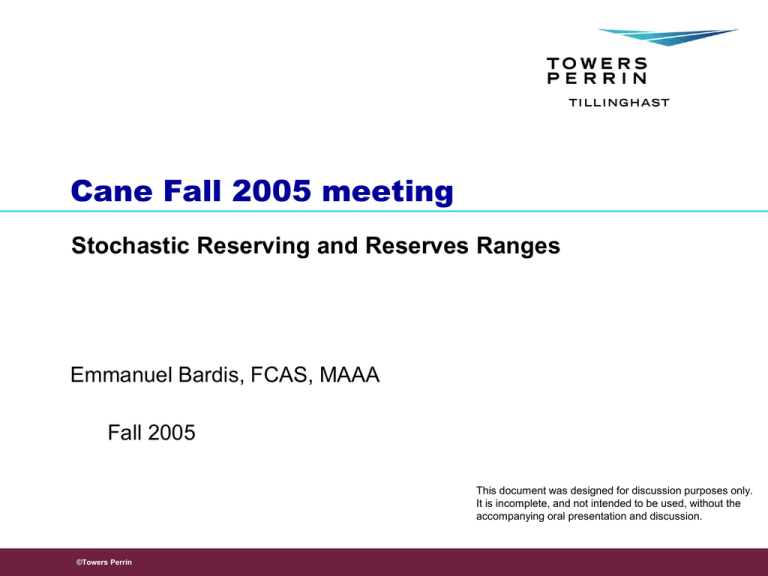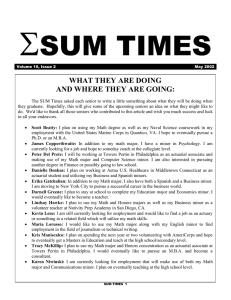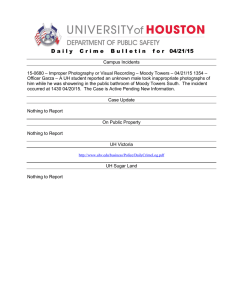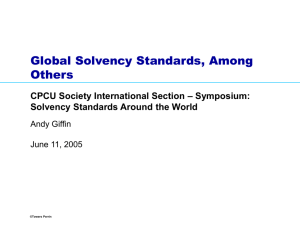Cane Fall 2005 meeting Stochastic Reserving and Reserves Ranges Fall 2005
advertisement

Cane Fall 2005 meeting Stochastic Reserving and Reserves Ranges Emmanuel Bardis, FCAS, MAAA Fall 2005 This document was designed for discussion purposes only. It is incomplete, and not intended to be used, without the accompanying oral presentation and discussion. ©Towers Perrin ©Towers Perrin Presentation components Deterministic vs. Stochastic methods and ASOP #36 Various types of stochastic models Criteria for model selection Aggregate claim liabilities distributions Range of reasonable estimates and materiality standards ©Towers Perrin ©Towers Perrin 2 How actuaries currently handle reserve ranges? ©Towers Perrin ©Towers Perrin 3 Deterministic vs. Stochastic Methods Deterministic methods provide the best estimate of claim liabilities Stochastic methods are more informative than deterministic methods Produce a full distribution of possible outcomes in addition to the best reserve estimate Provide basis for evaluating range of reasonable estimates and RMADs Provide confidence levels of held reserves Consider the volatility of the reserves for each individual line, together with the correlation of losses across the various lines ©Towers Perrin ©Towers Perrin 4 Why such a limited use of stochastic methods? A general lack of understanding of the methods Lack of flexibility of the methods, including lack of suitable software Lack of immediate need -- why bother when traditional methods suffice for the calculation of a best estimate? Lack of a clear guidance (accounting or actuarial) on how to calculate reserve estimates SSAP # 55 accounting guidance says that the held reserves must be “management’s best estimate” (?) of the actual liabilities ©Towers Perrin ©Towers Perrin 5 Guidance according the ASOP #36 According to ASOP #36 “Statement of Actuarial Opinion Regarding Property/Casualty Loss and LAE Reserves” “In estimating the reasonableness of the reserves, the actuary should consider one or more expected value estimates of the reserves, except when such estimates cannot be made based on available data and reasonable assumptions” Translation: We must find different ways to calculate the expected value (i.e. the mean) of the unknown distribution. The chance of getting an expected value equal to the actual claim liability amount is virtually zero. ©Towers Perrin ©Towers Perrin 6 More ASOP #36… “Other statistical values such as the mode or the median (50th percentile) may not be appropriate measures for evaluating loss and LAE reserves, such as when the expected value estimates can be significantly greater than these other estimates” Translation: That’s easy! Actuaries must be conservative “The actuary must use various methods to arrive at expected estimates… it is not necessary to estimate or determine the range of all possible values” Translation: We are, in essence, asked to concentrate our efforts on calculating the statistical mean, not the associated distribution ©Towers Perrin ©Towers Perrin 7 ASOP#36 concludes “A range of reasonable estimates… could be produced by appropriate actuarial methods… The actuary may include risk margins in a range of reasonableness estimates… a range… however, usually does not represent the range of all possible outcomes” Translation: Look at various distributions and select among them. ASOP here is unclear on distinguishing between: The range of Best Estimates and The range of actual outcomes ©Towers Perrin ©Towers Perrin 8 Calculation of ranges employing multiple projection methods The actual distribution has a wider range Best estimate Method #1 ©Towers Perrin ©Towers Perrin Best estimate Method #2 9 Stochastic Theory and Various Types of Models ©Towers Perrin ©Towers Perrin 10 All risks that contribute to the uncertainty of claim liabilities estimates Total Risk Process Risk i.e. fair die Actual claim liabilities ©Towers Perrin ©Towers Perrin Parameter Risk i.e. unfair die Expected claim liabilities Model Risk i.e. 6 unfair dice Model Estimate 11 ”Chain Ladder” type of models Example: Mack model assumptions: I. The expected loss amount at time n, is equal to the product of the known paid loss amount through time (n-1) times a “true” unknown loss development factor II. No correlation among accident years exists III. The variability of the link ratios is inversely proportional to the magnitude of the loss amounts The Mack model provides the Mean and “Standard error” of the claim liabilities, where: Standard error = E[(Actual–Model Estimate)2 | Triangle] ©Towers Perrin ©Towers Perrin 12 “Simulation” type of models Bootstrapping is a powerful, yet simple, technique that employs simulations, avoiding the fit of complex models The chain ladder method (CLM) produces identical reserve estimates to a Generalized Linear Model model (OPD) Incremental fitted payments from the CLM are compared to historical increments, producing residuals Regression residuals are approximately independent and identically distributed around zero Bootstrapping involves sampling with replacement of the residuals. The simulated residuals produce forecasted incremental payments ©Towers Perrin ©Towers Perrin 13 “Incremental” type of models These modes employ log-incremental rather than cumulative payments They fit curves across accident, development and payment years producing “parsimonious” models The statistical framework allows the user of the model to test the significance of the parameters Goodness of Fit tests allow the user to “tailor” the model parameters to fit the characteristics of the data Examples are the Christofides “log-incremental” model and the “ICRF’s” model ©Towers Perrin ©Towers Perrin 14 Graphs for Incremental models 14,000 Cumulative P ayments Standardized Residuals Amount P aid 12,000 10,000 3 8,000 AY0 AY1 6,000 AY2 AY3 AY4 AY5 2 6 1 4,000 2,000 AY6 0 10.00 1 2 3 4 Development Year 5 Residuals 0 Log - I ncremental P ayments 7.00 6.00 5.00 4.00 AY0 AY1 AY2 AY3 1 2 3 4 5 6 AY4 AY5 -2 -3 AY6 3.00 0 ©Towers Perrin ©Towers Perrin 0 -1 8.00 P aid Log of Amount 9.00 0 1 2 3 4 Development Year 5 6 Development Year 15 Bayesian type of models Incremental models are fitted to historical data and produce “best fitted” parameters. Future payments are then calculated based on these parameters Bayesian models assume instead a “prior” distribution of the parameters Based on the Bayes Theorem and the historical data, a “posterior” distribution of the parameters is produced Monte Carlo simulations produce the distribution of the parameters and the future payments Bayesian models incorporate the informed judgment of the model’s users ©Towers Perrin ©Towers Perrin 16 Criteria for model selection Data: Are the model assumptions satisfied by the data? Do correlation across accident years exist? Is there any negative loss development present? Cost/Benefit considerations: What is the marginal benefit of complicated models? What is the cost of “specialist” software? How difficult is to explain to management? Reasonability checks: Standard errors should increase for immature years Goodness of Fit: find a model that best “fits” the data Complexity must be appropriately penalized ©Towers Perrin ©Towers Perrin 17 Aggregate Claim Liabilities Distribution ©Towers Perrin ©Towers Perrin 18 What about aggregate distributions? The 75th percentile of the combined distribution of two lines of business is generally NOT the sum of the 75th percentiles of the individual distributions The former is true only in the case of perfect correlation between the two lines. This is very unlikely! Generally the aggregate distribution is less risky than the sum of the risk of the parts The volatility of the aggregate distribution increases: By the volatility of the individual lines The correlation between the lines ©Towers Perrin ©Towers Perrin 19 Impact to the 75th percentile of the aggregate distribution Correlation Impact for Two N(100,30) Lines Impact of Correlation and Volatility 7.0% 20.0% St Dev 25 18.0% Increase over Uncorrelated 75th Percentile 75th percentile 5.0% 4.0% 3.0% 2.0% 1.0% St Dev 50 St Dev 75 16.0% St Dev 100 St Dev 200 14.0% 12.0% 10.0% 8.0% 6.0% 4.0% 2.0% Correlation Between Lines ©Towers Perrin ©Towers Perrin 100% 90% 80% 70% 60% 50% 40% 30% 20% 10% 0.0% 0% Increase over Uncorrelated 75th Percentile 6.0% St Dev 10 0.0% 0.0% 25.0% 50.0% 75.0% 100.0% Correlation Between Lines 20 Theory of Copulas Copulas provide a convenient way to express the aggregate distributions of several random variables Copula components: The distributions of individual random variables Correlations of these variables Correlation coefficients measure the overall strength of association across various distributions Copulas can vary that degree of association over the various parts of the aggregate distribution Example: for workers comp and property losses the correlation is higher in the tail of the distribution ©Towers Perrin ©Towers Perrin 21 Comparison of Copulas 925,000 Normal Copula 875,000 Student t Loss amounts 825,000 Gumbel Copula 775,000 725,000 675,000 625,000 0. 99 0. 9 0. 8 0. 7 0. 6 0. 5 0. 4 0. 3 0. 2 0. 1 0. 01 575,000 Percentiles ©Towers Perrin ©Towers Perrin 22 Range of Reasonable Estimates and Standards of Materiality ©Towers Perrin ©Towers Perrin 23 “Standards” for comparing actuarial estimates “Statistical” materiality in an actuarial/statistical context: Is the difference between two actuarial estimates significant different from each other? Parameter risk is relevant here. We are concerned with the variability of the “Expected” claim liabilities only “Financial” materiality in a financial reporting context: Would users of financial statements draw different conclusions if a different reserve estimate is booked in the financial statement? Total risk is relevant here. We are concerned with the variability of the “Actual” claim liabilities ©Towers Perrin ©Towers Perrin 24 We follow a “null hypothesis” testing approach Type I error Type I error Significance level Significance level Lower Materiality standard Upper Materiality standard Carried reserves ©Towers Perrin ©Towers Perrin 25 “Statistical” materiality standards at a 7.5% significance level The coefficient of variation (CV) of claim liabilities is proportional to the “inherent” risk of a line of business Sta n d a rd s a s a % o f c a rrie d re se rve s 25.0% Up p e r L o we r 20.0% The range implied by the statistical standards is proportional to the volatility of the line of business CV 15.0% 10.0% “Financial” materiality ©Towers Perrin ©Towers Perrin 5.0% Liability Other Comp Workers Liability Auto 0.0% Personal standards should consider the risk of the claim liabilities in comparison to Surplus and Net Income 26 A little diversion: Financial vs Statistical standards Even if the carried and indicated reserves are “statistically” indistinguishable from one another the risk of material adverse deviation still remains! It happens in the case where: Upper “statistical “ range - carried reserves >= Financial materiality standard The Upper statistical range is produced by “appropriate” actuarial methods and sets of assumptions… Financial Materiality Lower Statistical range ©Towers Perrin ©Towers Perrin Carried reserves Standard + Carried reserves Upper Statistical range 27



